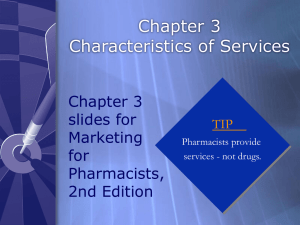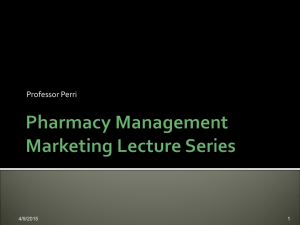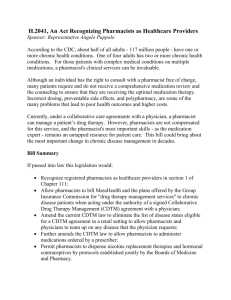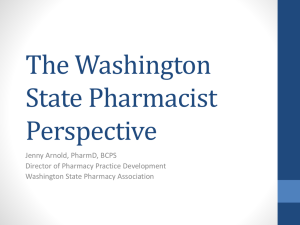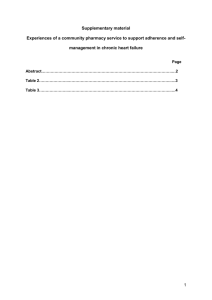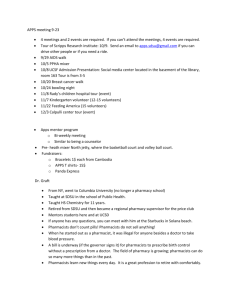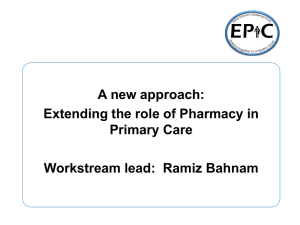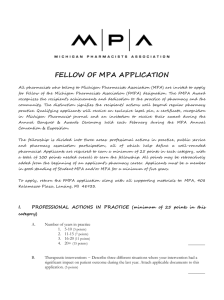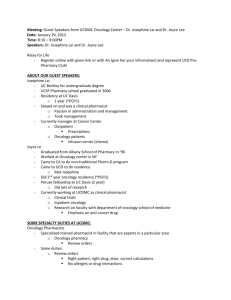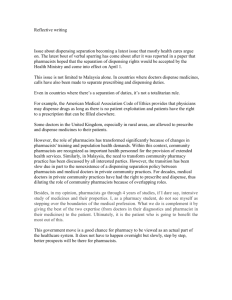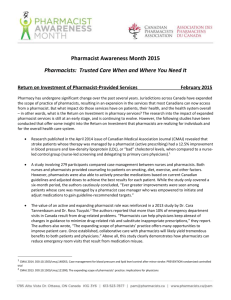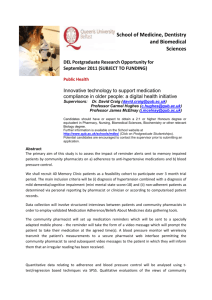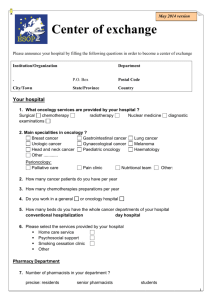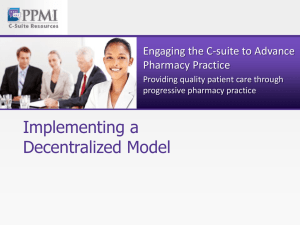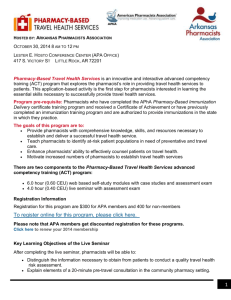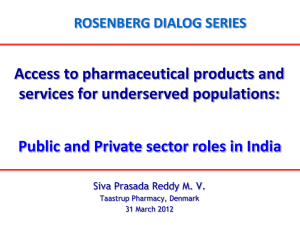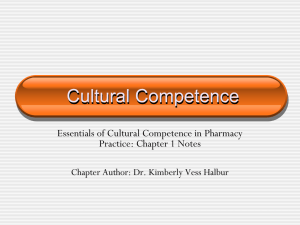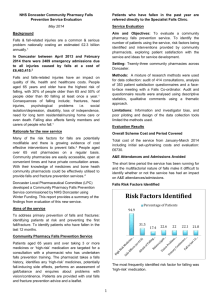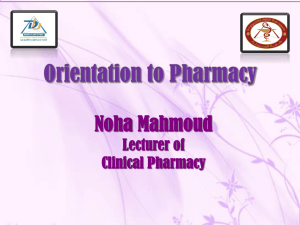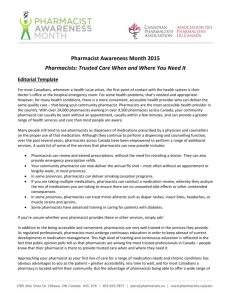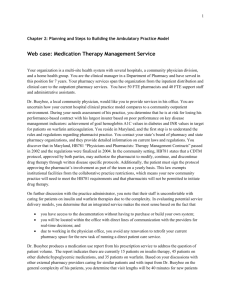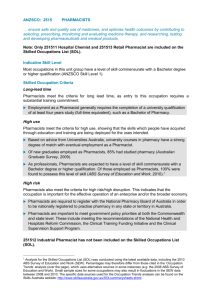Chapter 1 - Introduction to Marketing
advertisement
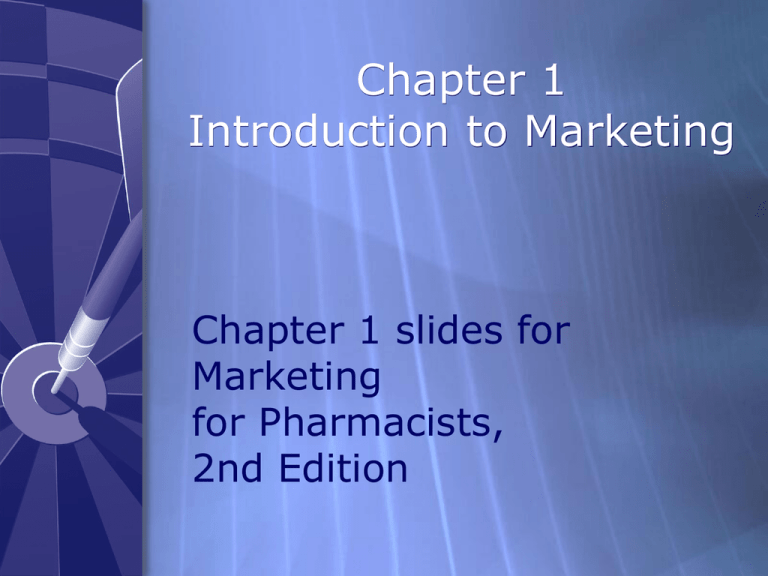
Chapter 1 Introduction to Marketing Chapter 1 slides for Marketing for Pharmacists, 2nd Edition Learning Objectives Define the term marketing. Describe four key elements associated with the act of marketing. Compare and contrast transactional marketing and relationship marketing. Analyze some of the misconceptions surrounding the practice of marketing. Justify the need for pharmacists to market themselves and their services. Differentiate various approaches to marketing from the “marketing concept.” Assess key obstacles to the marketing of pharmacists’ professional services. Basic Marketing Principles What is marketing? And why does it have such a bad reputation? TIP Marketing is not bad --only some marketers. Honesty and Ethical Ratings of People in Different Professions, 2005 Gallup Poll % Very high/ High % Average % Low/ Very low Nurses 82 15 3 Pharmacists 67 28 4 Medical doctors 65 31 4 High school teachers 64 27 7 Policemen 61 31 8 Clergy 54 35 8 Bankers 41 48 10 Journalists 28 44 27 Lawyers 18 46 35 Congressmen 14 44 41 Advertising practitioners 11 50 35 Car salesmen 8 41 49 Telemarketers 7 31 60 How have marketers benefited you and society? Whether marketing is “good” or “bad” depends on how it is practiced. TIP Actual practice depends on your approach. Marketing Defined TIP It’s all about exchanges. Definition of marketing Exchanges between people in which something of value is traded for the purpose of satisfying needs and wants Pharmacist exchanges Dispensing a drug Helping patients select OTC medications Providing drug information to patients or health care professionals Taking a patient’s blood pressure Counseling patients about drug regimens Pharmacists have exchanges with Patients Physicians Third-party insurers Their employer Their boss Pharmacist co-workers Transactional versus Relationship Marketing Two ways of looking at marketing exchanges (a.k.a. transactions) Way 1: Isolated, individual transactions; participants never expect to do business again (transactional marketing ) Way 2: Series of transactions over time Called relationship marketing (RM) RM focuses on developing long-term relationship (i.e., customer loyalty) Relationship marketing Parties focus less on bargaining hard for deals and more on meeting the needs of the other party. Marketers cultivate relationships over time that will benefit both parties. The choice Transactional marketing – get what you can and get the patient out of the door Relationship marketing – every interaction with a customer is an opportunity to help the customer and strengthen the relationship Characteristics of Relationship Marketing Develop a relationship with customer. Collect and manage customer information. Individualize your services to customers. Involve front-line personnel. Emphasize longterm outcomes. Pharmaceutical Care Establish therapeutic relationship Assess and record patient needs. Create an individualized care plan. Delegate clerical tasks to free up time for professional duties. Monitor impact on patient outcomes. Is pharmacy practice predominantly transactional or relationship-oriented? Transactional Orientation Relationship Orientation Every pharmacist is a marketer. Everything pharmacists do can be called marketing: Dispensing a prescription drug C Assisting patients in the selection of OTC medications C Providing drug info to patients or health care professionals C Taking a patient’s blood pressure C Counseling patients about drug regimens C Recruiting pharmacists for a new job C Educating pharmacy students Why study marketing? Marketing is A way of problem solving in the real world A way of influencing others Application of marketing can Help you get the job you want Make you a more effective pharmacist Misconceptions about Marketing Misconceptions about marketing Marketing is selling or advertising. Marketing Research Selling Pricing Marketing Advertising Merchandising Distribution Other misconceptions about marketing Marketing is evil. Health care professionals do not need to market. Employee pharmacists do not need to market. Only retail pharmacists need to market. Approaches to Addressing Marketing Problems in Pharmacy The way you approach a problem will determine how it is solved. Some process-centered approaches to marketing Production – fast and cheap Sales – fast and cheap with heavy selling Product – better mousetrap Customer-centered approaches to marketing Marketing concept Needs and wants Targeted customers Products and services that satisfy Societal marketing Considers societal impact What is the dominant approach in pharmacy practice? What is your approach? Major Trends that Will Affect Pharmacist Practice Consumer-driven health care (CDHC) Health savings accounts High-deductible insurance plan Cost sharing Disease/ wellness management Aging of the baby boomers Retirement of post-World War II baby boom generation Demanding, activists Unwilling to accept health care status quo Expect to live longer and healthier lives throughout their retirement Around-the-clock society People expect services and products 24/7/365. Convenience is no longer an option in pharmacy practice. Hours Location Speed Choice Service technology Voice-operated telephone and information systems Bar-code and RFID tracking Robotics Service technology: Robotics Using Technology to Serve Patients Speed service Touch-screen interactive kiosks Electronic refill reminders Electronic prescribing, fax prescribing ATM-like dispensing machines Increase service Convenience/accessibility Telepharmacy, telephone call centers Internet pharmacy Touch-screen interactive kiosks Diagnostic technologies (e.g., blood pressure machine) Videos and other educational technologies Web education, CD ROMs Customize service Personalized patient e-profiles Customer relationship management (CRM) cards Interactive kiosks Interactive Web pages Improve service quality, solve Telephone call centers drug-related problems Electronic prescribing Maintain a patient relationship Personalized patient e-profiles CRM cards Web support groups Health care budgetary constraints Rising health care expenditures concern government and other payers. Medicare, Medicaid, Social Security, and other funding responsibilities Funding battle among health care providers Health care marketers must compete for funds. Healthcare innovations Pharmacogenomics Nanotechnology Rising global competition Medical tourism Thailand, India, Malaysia, Mexico, and Canada competing for the U.S. health care dollar Patients without health care insurance or large-deductible health insurance plans Drug importation/exportation Large cross-border price differentials Key problems with marketing pharmacist services Control of practice by nonpharmacists Product orientation Conflicting professional and merchant roles Poorly defined image of pharmacists among public Pharmacist shortages Silos of health care Demand for pharmacists New pharmacies opening daily Pharmacist shortages Rising pay Overwork Changing responsibilities Nursing Home Home Health Insurer Pharmacy Dr’s Office Hospital Conclusion Marketing can change your way of thinking about current pharmacy practice. The goal of this course is to help you develop a marketing mindset. Application of marketing principles can help you change pharmacy practice. Marketing can give you the tools to successfully promote yourself, your ideas, and the profession. Questions?
